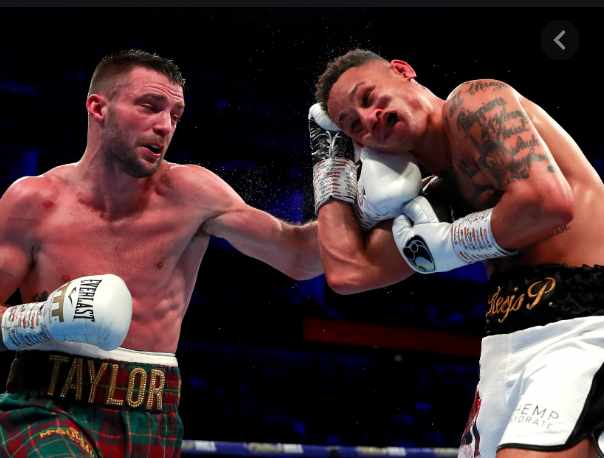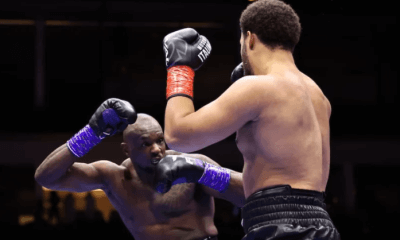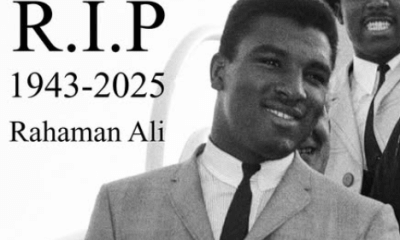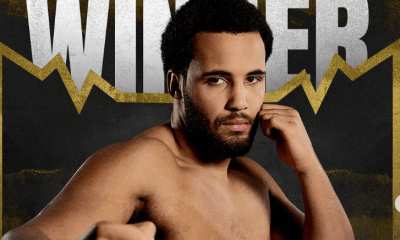Featured Articles
The Top Ten Light-Welterweights of the Decade: 2010-2019

140lbs is far and away the most difficult decadal divisional ranking I have put together. The problem was losses and how to weigh them – is it better for a fighter to meet six top men with a 50-50 return or to fight just two ranked contenders and return a 100% win ratio? I have done my best with such questions and I think it’s led to an interesting and varied list and one that is excitingly weighed towards active fighters currently in or around their primes.
Rankings are by Ring for 2010-2012 and TBRB for 2013 to 2019.
10 – Zab Judah
Peak Ranking: 3 Record for the Decade: 6-4 Ranked For: 34% of the decade
Zab Judah was the old man of the division in 2010 when he returned from 147lbs to once more ply his trade at the poundage that made him famous – and he was the old man of the division still when someone named Cletus Seldin stopped him in eleven rounds last July.
Zab was tempted back up to 147lbs in spots through the decade but it seems that at 140lbs he had a rule, and the rule was top talent. Nearly every fighter Judah met at light-welterweight during the decade was a ranked man, and usually they were favoured to beat him. 27-0 puncher Lucas Martin Matthysse was certainly an interesting choice for his first major opponent back in his home territory of 140lbs and it made for an interesting fight. Seen as somewhat controversial in some corners of the boxing world, the fight was indeed close, Judah outboxing a stubbornly shy Matthysse early, Matthysse cornering Judah and tattooing him with right hands late; any close scorecard is reasonable and certainly no robbery was perpetrated against Matthysse that night. The one-time bad boy of the division was back.
He looked great in dispatching Kaizer Mabuza (ranked seven) in early 2011 and if you have any doubts about his finding God between his light-welterweight runs, listen to his post-fight interview for this fight; still an underdog, he crushed Vernon Paris (ranked ten), winning all but the eighth before closing the blinds on him in the ninth, his speed dazzling.
Judah lost too. He was stopped by Amir Khan and despite a thrilling championship-rounds rally, was out-pointed by Danny Garcia. Despite this, and his ageing legs, the veteran Judah is good for the spot.
09 – Amir Khan
Peak Ranking: 2 Record for the Decade: 12-4 Ranked For: 40% of the decade
The most important fight of Amir Khan’s career was his 2010 clash with Marcos Maidana. His disastrous 2008 first round knockout loss to Breidis Prescott had loomed over every contest he had fought since, but not after this; Khan absorbed brutal shots from Maidana as he was pasted all over the ring in a dramatic tenth round but he proved himself tough enough to drag himself home for a close points victory. It was redemption and a thing of beauty, arguably the fight of the year, certainly one of the fights of the decade at 140lbs.
It was also Amir Khan painted in microcosm as all his strengths and weakness were laid glaringly bare. Fast hands and excellent punch selection were compromised by poor concentration; overall quickness was compromised by lazy footwork – poor punch resistance and some balance issues dented what should have been a glittering package. Khan made peace with these shortfalls on this night and embraced what he was, a gifted but flawed fighter.
It is hard to imagine then a more fitting passing of the torch than his 2011 fight against Zab Judah, the original brilliant but flawed light-welterweight for this timeframe. Khan’s superiority was near total but his knockout of Judah was not without controversy, a borderline low-blow bodyshot the final punch. That said, the four completed rounds were without wrinkles; Khan’s superiority was near total.
Losses followed but there were circumstances. His 2012 knockout loss to Danny Garcia was clean and there can be no complaints but his 2011 loss to Lamont Peterson was beset with controversy. You can take your pick from Khan’s allegations of poor refereeing, incompetent judging, out-and-out corruption as film emerged of a man apparently connected with the Peterson camp interacting with one of the judges, and finally the discovery post-fight that Peterson was using synthetic testosterone, a banned substance or at the very least one that needs to be declared. The fight, which I scored 112-112, was a disaster for boxing and it is hard to hold it against Khan in the normal sense.
It also should be noted that the strangeness surrounding that fight sees Peterson falls short of the list. Unconvincing as it is, it remains by far Peterson’s best win, his second being over Dierry Jean, not a combination that sees him named as one of the ten best from this decade.
Khan makes it, balanced neatly between being the last debatable entry and the first top ten lock.
08 – Lucas Matthysse
Peak Ranking: 1 Record for the Decade: 14-5 Ranked For: 52% of the decade
There is little to separate Lucas Matthysse and Amir Khan but in keeping with the theme of the list, the difference was losses: more of Matthysse’s were close and debatable. Viktor Postol beat him clean in 2015, his last fight at 140lbs, as did Danny Garcia in 2013 but in earlier fights with Zab Judah and Devon Alexander, he was very unlucky. I saw him winning both fights by a single point, a point earned in each case by a knockdown and although these were certainly no robberies, that Matthysse received the nod in neither split decision loss can certainly be considered a misfortune.
At the very least, neither proved themselves a definite superior to Matthysse.
For key wins, Matthysse holds impressive stoppage victories over Ajose Olusegun and Lamont Peterson, and he was the first man to lay both low, his destruction of Peterson, who he dropped three times in three rounds, brutal.
In 2015 he ran into fellow puncher Ruslan Provodnikov and the two put on the expected fight of the year candidate. This fight is key in Matthysse’s 140lb legacy, not for proving what he was, but for what he was not; he was not a one-dimensional pressure slugger. He deployed boxing to edge this fight and most especially in the first and second rounds, it was superb. More, he controlled the range almost absolutely in the first half of the fight, deploying uppercuts and a left hook to devastating effect as Provodnikov plodded into his kill-zone.
Matthysse lost a little too often to menace the top five, but it is difficult to imagine the top ten without him.
07 – Devon Alexander
Peak Ranking: 3 Record for the Decade: 24-1 Ranked For: 25% of the decade
Devon Alexander is tough to rank for the poundage and decade to hand. Never ranked higher than number three, he was also a prospective pound-for-pound number one according to HBO’s Max Kellerman. This is the kind of division of opinion Alexander prompted. On the one hand, he seemed, in the wake of his 2010 knockout of the iron-jawed Juan Urango, to have every single attribute a fighter might need for the very top, but there was an underwhelming stiffness in his work that never quite satisfied.
Some dissatisfaction began to manifest itself as regarded the scorecards rendered in his favour, too. In his very next contest against Andriy Kotelnik, Alexander made both his own corner and the HBO commentary team very nervous, but he deserved his victory, for all that it was closer than most expected – I myself had it to Alexander by a single round, with a swing round in his favour.
His next fight, with Lucas Matthysse was legitimately debateable, and I wasn’t alone in seeing that as a win for Matthysse, although it was close, and because it was close the result is respected for the purposes of this list.
Before the Matthysse fight, Alexander posted his single loss at the weight, to Timothy Bradley. Bradley misses out on this list because that was his single 140lbs win of note for the decade. Alexander, meanwhile, is included, but a little lower than he might have been if not for his meeting with Bradley. Alexander was pulled late in the fight by the doctor but looked quite a lot like a man who didn’t want to be there for more than the reported reasons, specifically that his eyes were “burning” after the latest in the long line of headclashes. He dropped a technical decision.
After that it was 147lbs for Alexander and some less rewarding years; the timing of his departure limits his standing here.
06 – Mikey Garcia
Peak Ranking: Ch. Record for the Decade: 20-1 Ranked For: 13% of the decade
Mikey Garcia sitting at six does not sit particularly well with me. Garcia fought a tiny handful of contests at the weight but in those few contests he out-performed Devon Alexander, who fought a similar number of contests, so ranks above him.
For all that it feels a little awkward it can be stated with surety that reviewing footage of 140lbs Mikey Garcia was a pleasure. There are better fighters ranked above but there are none with more technical acumen than he. Watching him box was a pleasure.
Mikey emerged as a legitimate 140lb fighter in 2017 in crushing Adrien Broner with generalship and bodywork, outwaiting him after taking an early lead. Mikey did no more than he needed to, but he consistently did enough, seizing control and only relinquishing it for spells late in the fight when it had essentially been decided.
This was also his strategy against Sergey Lipinets, the former kickboxing champion, in what was his definitive performance at the 140lb limit. Lipinets, unlike Broner, refused to go away strategically- speaking but Mikey battered him with straight punches early before out-jabbing him in the middle rounds and out-fighting him late.
Mikey was never stretched in his brief visit to light-welterweight, was unbeaten, crowned champion against Lipinets and consistently outclassed the opposition. His departure to 147lbs was a shame for his 140lb legacy but he made himself one of the key fighters of the divisional decade.
05 – Jose Carlos Ramirez
Peak Ranking: 2 Record for the Decade: 25-0 Ranked For: 20% of the decade
Jose Carlos Ramirez slides in ahead of Mikey Garcia based upon his divisional longevity, an entire career contested at the poundage and in the decade to hand.
Ramirez, young, American, a puncher, an action fighter, has generated heat for some time but his graduation night fight against Antonio Orozco in 2018 turned heads. Orozco, who was tough and brave and aggressive and all the things we want our prize-fighters to be, has never really recovered from the beating Ramirez put upon him. Unbeaten going in he is 1-1 since and looks a changed man. Ramirez, who fights a little shorter than his 5’10, is an aggressive pressure boxer with little guile to his punching game but who is clever about space and time. He also has a well-made jab and although the punches he throws behind that jab sometimes look a little wild and can leave him vulnerable to punches up the middle, they are hard and consistent.
Orozco, ranked four no less, twice climbed from the canvas, first from a right hand to the head after Ramirez swarmed him out of position and connected big, then from a left hook to the body that hurt just to look at. Ramirez won no fewer than eleven of the twelve rounds on the scorecards of all three judges. It was a massacre.
In early 2019 more was made than should have been of the trouble current number nine contender Jose Zepeda caused Ramirez in a worthy losing effort, but he did, perhaps, expose certain weaknesses in Ramirez, who it should be noted hasn’t yet reached thirty fights. Zepeda wore his right guard low to neutralise the left hook and pivoted and flicked his own jab to neutralise that of Ramirez – but he also lost eight rounds on my card, and that of one of the judges.
Ramirez summited, at least as far as the decade at hand is concerned, in his July 2019 contest with Maurice Hooker. This was always to be a defining fight for the winner, an American remaining unbeaten in a clash of beltholders. Ramirez emerged the man in charge, dragging Hooker into a dogfight from the very first round, dropping him, hurting him, before retiring him on the ropes in the sixth.
It will be interesting to see what it takes to lay Ramirez low in the 2020s.
04 – Regis Prograis
Peak Ranking: 1 Record for the Decade: 24-1 Ranked For: 25% of the decade
Regis Prograis shades Ramirez by the narrowest of margins and based upon a loss. At the decade’s end he dropped a majority decision to Josh Taylor in a meeting of the division’s two top contenders; the decision was based upon geography. In America, Prograis would likely have been given the nod by the narrowest of margins, in the UK, Taylor took it. In reality the two were so evenly matched they might fight consecutive draws at a neutral venue.
As to the wins that helped him into the top five the definitive one is over Julios Indongo, who was coming off a defeat to pound-for-pounder Bud Crawford. Prograis got the job done more quickly than Crawford, dispatching Indongo in just two rounds. Hard jabs to the body and chest, fast, cornering feet and gorgeous slipping of the Indongo jab forced the taller man to let Prograis inside. Here, he did his best work and although his performance was reckless, it was deeply impressive. Stiffening power in the southpaw jab and obliterating power in the overhand left saw Indongo broken. The speed of the Prograis pressure was, and remains, unequalled in the division.
A year later, Prograis met with strapholder and number four contender Kiryl Relikh, the all action Belarusian who bounced back from a tough 2016 to win a rematch with Rances Barthelemy (having been very unlucky to drop the decision in their first fight) and defeat Eduard Troyanovsky in impressive back-to-back performances. Relikh, who had never been stopped, was dropped by a bodyshot in the very first round by Prograis who then set out to torture him with power-boxing two classes above anything Relikh had ever seen, prompting his corner to pull him midway through the sixth. Prograis dispatches top class opposition with ease.
A special fighter then, just one who ran into another one in the shape of Josh Taylor. That fight was close enough that Prograis deserves a rematch; if he gets one, it will be in the next decade.
03 – Josh Taylor
Peak Ranking: 1 Record for the Decade: 16-0 Ranked For: 23% of the decade
Josh Taylor’s career trajectory has been sensational. He has arguably been the story of the 140lb decade, and he could be found duking it out with number three contender Viktor Postol in just his thirteenth fight.
Taylor looked to have got past that challenge by the barest of margins that 2018 night in Glasgow despite the ludicrously wide official scorecards, but he was enormously impressive none-the-less. Counter-surging throughout he never let Postol get away from him and take control of the ring and the glorious knockdown he scored in the tenth made him a winner as I saw it.
A year later Taylor, now 14-0, found himself in the ring with Ivan Baranchyk, the number seven contender and a legitimate strongman puncher, a serious challenge for the young Taylor. Taylor dropped Baranchyk twice in the seventh to take a clear unanimous decision win.
This led, in October of 2019, to the already legendary night in London when Taylor met Prograis in the unarguable 140lb fight of the decade. This is a fight of which it might be said that neither competitor deserved to lose but it felt more than that: both competitors deserved to win. This was reflected in the draw I scored, and one of the judges scored, the other two officials seeing it for Taylor.
What was most impressive on the night was seeing Taylor adjust to the early running, using the learning from his more recent fights to show Prograis different looks, moving, countering, and most of all butting up on the inside for exchanges. Taylor never dominated the fight but he outfought Prograis for stretches enough that he was the likeliest winner. That superb result has made him the #3 for the old decade and the de facto number one going into the new.
02 – Danny Garcia
Peak Ranking: Ch. Record for the Decade: 21-2 Ranked For: 34% of the decade
I suspect there will be some who respond to Danny Garcia ranking at number two with surprise and even horror. I sympathise.
There was something underwhelming about Danny when he broke onto the world scene in 2012 against an ancient Erik Morales and his performance, too, in that fight was underwhelming. But that didn’t mean he wasn’t winning, that he did win, and by my eye quite comfortably. What I did not know about Danny then was that these were typical operations. He missed, yes, but he deployed controlled boxing nonetheless and with technical surety. Combined with his natural size and swiftness, this made him a formidable fighting machine at the poundage, and one that could afford to wait.
So, he did wait, boxing at a single sure pace until it was time to go through the gears, like he did late in that first Morales fight.
Danny redrew the way he was viewed by boxing in his very next fight against number one contender Amir Khan. An underdog who did not excite as an opponent, Danny was expected to be out-sped and outhit and probably stopped. He turned those tables after two tough rounds but in truth, he made no magic; he just bet on himself as better, then calmly, economically deployed himself and waited. A huge counter left hook had Khan down and in serious trouble; he never recovered and was brutally dispatched in the fourth much to the chagrin of the HBO commentary team. It was an easy night’s work.
Whispers had somehow emerged that Danny had been a little lucky against Morales, so Danny rematched him and blasted him out, then he matched Zab Judah, the number four contender, dropped and decisioned him and then he matched a second number one contender in Lucas Matthysse, who he outpointed in a thriller.
He had exclusively matched and beaten ranked opposition for five consecutive fights, outpointing veterans Kendall Holt and Nate Campbell before he had even begun that run. There is no more impressive sequence in the light-welterweight decade.
The bottom line then: Danny went 5-0 against top ten opposition, which is better than our number three, Josh Taylor; he beat up two #1 contenders whereas Taylor has defeated just one, in a life and death struggle; and he spent longer ranked in the decadal divisional top ten. As a Scotsman I would love to rank Taylor above Danny, but how can it possibly be justified?
01 – Terence Crawford
Peak Ranking: Ch. Record for the Decade: 26-0 Ranked For: 24% of the decade
There was never even a question of some another fighter claiming the number one spot. Terence Crawford is as locked in as almost any number one has been in this series.
Although 140lbs was just a stopover on the way to 147lbs and from 135lbs where he reigned as champion, Crawford made maximum impact during a relatively short stay. He avoided alphabet ordained soft-touches in favour of legitimately excellent fighters with whom he could make legitimately excellent fights.
This, at least, was the theory. In reality Crawford knocked out every man he met at the weight with but a single exception in Viktor Postol. Postol was the first number one contender Crawford out-classed at 140lbs, but wouldn’t be the last. Crawford took his time in that fight and in others, boxing what tends to be labeled a “slow start” by television commentary teams but is in fact him taking a long hard look at his opponent. After three rounds, Postol was 2-1 up but who could doubt after watching Crawford land his dialed in southpaw left in the fourth and drop Postol twice in the fifth that he had been measuring Postol? He did not lose another round and Postol, a world class fighter, looked a novice next to him.
This is the affect giants have on their opponents.
Still, Postol did better than Thomas Dulorme, measured through five then ruthlessly dispatched in six; John Molina, battered out in three; Felix Diaz, the ranked welterweight who dropped down to take an awful beating at the hands of Crawford – Diaz has never been the same; others. This brought him to his second number one contender at the weight, Julius Indongo.
Lithe and long, Indongo, out of Namibia, had previously stopped number four contender Eduard Troyanovsky, and was the first man to do so. Indongo looks too relaxed to be really explosive but he has torque on his trailing left hand, especially on his uppercut. Himself a contender for this list, he met Crawford in his last fight at 140lbs in August of 2018. Their fight was not competitive. Crawford dispatched him in three rounds, brutalising him to the body.
Sometimes when a dominant fighter moves up in weight, there is a sense of disappointment but not when Crawford left for 147lbs. There was no point in his remaining at 140lbs. There was nobody there to test him.
The other lists:
Check out more boxing news on video at The Boxing Channel
To comment on this story in The Fight Forum CLICK HERE
-

 Featured Articles4 weeks ago
Featured Articles4 weeks agoThe Hauser Report: Zayas-Garcia, Pacquiao, Usyk, and the NYSAC
-

 Featured Articles3 weeks ago
Featured Articles3 weeks agoOscar Duarte and Regis Prograis Prevail on an Action-Packed Fight Card in Chicago
-

 Featured Articles2 weeks ago
Featured Articles2 weeks agoThe Hauser Report: Cinematic and Literary Notes
-

 Book Review2 weeks ago
Book Review2 weeks agoMark Kriegel’s New Book About Mike Tyson is a Must-Read
-

 Featured Articles4 weeks ago
Featured Articles4 weeks agoRemembering Dwight Muhammad Qawi (1953-2025) and his Triumphant Return to Prison
-

 Featured Articles7 days ago
Featured Articles7 days agoMoses Itauma Continues his Rapid Rise; Steamrolls Dillian Whyte in Riyadh
-

 Featured Articles3 weeks ago
Featured Articles3 weeks agoRahaman Ali (1943-2025)
-

 Featured Articles3 weeks ago
Featured Articles3 weeks agoTop Rank Boxing is in Limbo, but that Hasn’t Benched Robert Garcia’s Up-and-Comers


















